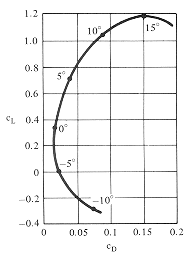|
In
order to quantify the lift/drag behavior of an airfoil it is advantageous
to define some non-dimensional coefficients of lift, CL, and
drag, CD. By using these non-dimensional quantities, measurements
made on scale models may be directly transferred to the full scale situation.
The
lift coefficient is defined as: CL
= L/qS , where
L is the lift force, S the area of the wing and q = (rU2/2)
is the dynamic pressure with r
the air density and U the airspeed. Similarly, the drag coefficient is
written as: CD
= D/qS , where D is the drag force and
the other symbols have the same meaning. The numerator and denominator
of these two equations have the dimension of force and so the equation
is dimensionless.
The
diagram shows how the lift and drag coefficients measured at a given airspeed
depend on the angle of attack for a particular airfoil. Maximum lift occurs
for this airfoil and airspeed for an angle of attack of 150.
The wing stalls as the angle of attack is increased beyond this value causing
the lift coefficient to drop rapidly while the drag coefficient continues
to increase. When the lift is less than the weight of the aircraft it looses
altitude and the angle of attack must be reduced to increase the lift.
Because stall is associated with flow separation from the wing, any control
surfaces on the trailing edge become ineffective and control of the stalled
plane is difficult. |
|
|
|
|
|
|
|
|
|
|
